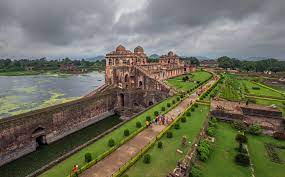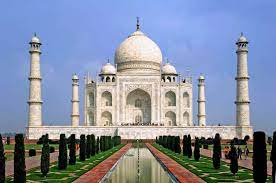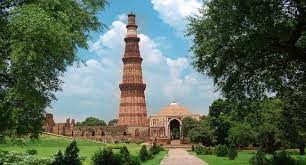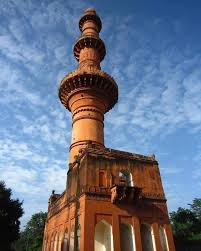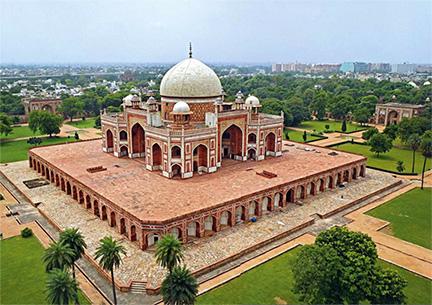Indo-Islamic Architecture | 11 Feb 2023
For Prelims: Characteristics and Main Features of Indo-Islamic Architecture.
For Mains: Indo-Islamic Architecture: History, Components, Characteristics, Examples.
What is the History Behind the Indo-Islamic Architecture?
- Islam spread to Spain and India in the seventh and eighth centuries Common Era (CE). Islam came to India, particularly, with Muslim merchants, traders, holy men and conquerors over a passage of six hundred years.
- In the early thirteenth century, large-scale building activity began under the Delhi Sultanate, established after the Turkish conquest of northern India.
- A noteworthy aspect of these migrations and conquests was that Muslims absorbed many features of local cultures and traditions and combined them with their own architectural practices which results in the modification of architectural elements.
- Those architectural entities or categories showcasing multiple styles are known as Indo-Saracenic or Indo-Islamic architecture.
- Hindus conceived manifestations of god everywhere in multiple forms as part of their religious faith, whereas, Muslims thought of only one with Muhammad as their Prophet.
- Hence, Hindus adorned all surfaces with sculptures and paintings. Muslims, forbidden to replicate living forms on any surface, developed their religious art and architecture consisting of the arts of arabesque, geometrical patterns and calligraphy on plaster and stone.
What are the Different Characteristics of Indo-Islamic Architecture?
Typologies of Structure
- Keeping in mind religious and secular necessities, architectural buildings like mosques for daily prayers, the Jama Masjids, tombs, dargahs, minars, hammams, formally laid out gardens, madrasas, sarais or caravansarais, Kos minars, etc., were constructed over a period of time.
- In spite of the Saracenic, Persian and Turkish influences, Indo-Islamic structures were heavily influenced by prevailing sensibilities of Indian architectural and decorative forms.
Categories of Styles
- The study of Indo-Islamic architecture is conventionally categorised into:
- The Imperial Style (Delhi Sultanate)
- The Provincial Style (Mandu, Gujarat, Bengal, and Jaunpur)
- The Mughal Style (Delhi, Agra, and Lahore)
- The Deccani Style (Bijapur, Golconda)
Decorative Forms
- These forms included designing on plaster through incision. The designs were either left plain or covered with colours.
- Motifs were also painted on or carved in stone. These motifs included varieties of flowers, both from the sub-continent and places outside, particularly Iran.
- Many designs of flower motifs decorating the ceilings were also to be found on textiles and carpets.
- The lotus bud fringe was used to great advantage in the inner curves of the arches.
- The arches were plain and squat and sometimes high and pointed.
- Walls were also decorated with cypress, chinar and other trees, as well as with flower vases.
- In the 14th, 15th and 16th centuries tiles were also used to surface the walls and the domes.
- Other decorations included high (three-dimensional look) and low relief carving and profuse use of jalis.
- The techniques of tessellation (mosaic designs) and pietra dura were made use of for surface decoration particularly in the dado panels of the walls.
- The roof was a mix of the central dome and other smaller domes, chatris and tiny minarets.
| Dado Panels | Pietra Dura |
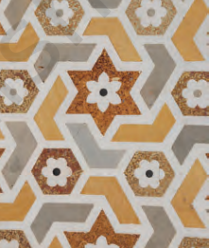 |
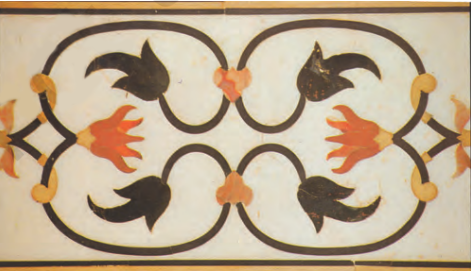 |
What are the Components of Indo-Islamic Architecture?
Minars
- One of the forms of stambha or tower was the minar, a common feature in the sub-continent. Two most striking minars of medieval times are the Qutub Minar in Delhi and the Chand Minar at Daulatabad Fort.
- The everyday use of the minar was for the azaan or call to prayer. Its phenomenal height, however, symbolised the might and power of the ruler.
Tombs
- Monumental structures over the graves of rulers and royalty were a popular feature of medieval India. Some well-known examples of such tombs are those of Ghyasuddin Tughlaq, Humayun, Abdur Rahim Khan-i-Khanan in Delhi, Akbar and Itmaduddaula in Agra.
- Beginning with the introduction of Quranic verses on the walls, the tomb was, subsequently, placed within paradisiacal elements such as a garden or near a body of water or both, as is in the case of the Humayun’s tomb and the Taj Mahal, which follows the charbagh style (a four quadrant garden with the four rivers of Quranic paradise represented).
- Such vast expanses of structured and stylised spaces signify the majesty, grandeur and might of the person buried there.
Sarais
- Sarais were largely built on a simple square or rectangular plan and were meant to provide temporary accommodation to Indian and foreign travellers, pilgrims, merchants, traders, etc.
- In effect, sarais were public domains that were populated by people of varied cultural backgrounds. This led to cross-cultural interaction, influences and syncretic tendencies in the local culture and at the individual level.
Structures for Common People
- One of the architectural features of medieval India was also a coming together of styles, techniques and decorations in public and private spaces of non-royal sections of the society.
- These included buildings for domestic usage, temples, mosques, khanqahs (hermitage of Sufi saints) and dargahs, commemorative gateways, pavilions in buildings and gardens, bazaars, etc.
What are the Examples of Indo-Islamic Architecture?
The city of Mandu
- It is located in Madhya Pradesh. Mandu’s natural defence encouraged consistent habitations by Parmara Rajputs, Afghans and Mughals. As the capital city of Ghauri Dynasty (1401–1561) founded by Hoshang Shah, it acquired a lot of fame.
- Mandu is a typical representation of the medieval provincial style of art and architecture.
- Provincial style architecture of Mandu is regarded as too close to the structures of Imperial Delhi to make a bold statement of local traditions.
- A significant aspect of the Indo-Islamic architectural experience was the lightness of the structures.
- It was a complex mix of official and residential-cum-pleasure palaces, pavilions, mosques, artificial reservoirs, baolis, embattlements, etc.
Taj Mahal
- The Taj Mahal is located in Agra. It is the finest specimen of Mughal architecture, exhibiting the most exquisite display of glory and richness. It was constructed in memory of Shah Jahan’s wife Arjumand Banu Begamor Mumtaz Mahal.
- It had all the features of Mughal architecture including the use of calligraphy, pietra-dura works, foreshortening technique, Charbagh style gardens and the use of water in the premises for decoration.
- Some of the unique features are:
- The jaali work in Taj Mahal is lace-like and is extremely fine
- The carvings on the marble were low relief
Gol Gumbad
- Gol Gumbad is situated in Bijapur of Karnataka. It is the mausoleum (group of tombs) of Muhammad Adil Shah (1626–1656), the seventh Sultan of the Adil Shahi Dynasty of Bijapur (1489–1686).
- Built by the ruler himself, it is a notable building despite being unfinished.
- The tomb is a complex of buildings such as a gateway, a Naqqar Khana (Drum house), a mosque and a sarai located within a large-walled garden.
- The Gumbad is a monumental square building topped with a circular drum over which stands a majestic dome, giving the building its nomenclature. The building rises to a height of over two hundred feet.
- It is the second-largest dome in the world.
- Along the drum of the dome, there is a whispering gallery where sounds get magnified and echoed many times over.
Jama Masjid
- Large mosques, spanning huge spaces, were also scattered across the Indian subcontinent during medieval times. Congregational prayers were held here every Friday afternoon.
- The prayer required the presence of a minimum of forty Muslim male adults.
- In medieval times, a city had one Jama Masjid, which along with its immediate surroundings became the focus of the lives of the people, both Muslim and non-Muslim.
- Such a mosque was large with an open courtyard, surrounded on three sides by cloisters and the Qibla Liwan. It was here that the mihrab and the mimbar (a short flight of steps used as a platform by a preacher in a mosque) for the Imam (the person who leads prayers in a mosque) were located.
Qutub Minar
- The Qutub Minar, built in the 13th century, is a 234-feet-high tapering tower divided into five storeys. The minar is a mix of polygonal and circular shapes. It is largely built of red and buff sandstone.
- It is characterised by highly decorated balconies and bands of inscriptions intertwined with foliated designs.
Chand Minar
- It was built in the 14th century, is a tower divided into four storeys. Now painted peach, its façade once featured chevron-patterned encaustic tile work and bands of Quranic verse.
- Although it looked like an Iranian monument, it was the combined handiwork of local architects with those from Delhi and Iran.
Humayun’s Tomb
- This tomb, built in 1570, is of particular cultural significance as it was the first garden-tomb on the Indian subcontinent.
- It was built under the patronage of Humayun’s son, the great Emperor Akbar.
- It is also called the ‘dormitory of the Mughals’ as in the cells are buried over 150 Mughal family members.
- The United Nations Educational Scientific and Cultural Organisation (UNESCO) recognized it as a World Heritage Site in 1993.
Other Examples
- Red Fort:
- Built by Shah Jahan in 1618 when he decided to move the capital from Agra to Delhi. It was the residence of Mughal rulers.
- UNESCO designated it as the World Heritage Site in 2007.
- Badshahi Mosque:
- Built during the reign of Aurangzeb. At the time of completion in 1673, it was the largest mosque in the world. It is located in Lahore, capital of the Pakistani province of Punjab.
- Agra Fort:
- One of the first constructions which started during the reign of Akbar.
- During the reign of Akbar, more than 5000 women stayed in his harem inside this fort.
- Fatehpur Sikri:
- One of the highlights of Indo-Islamic architecture was the creation of a new capital city by Akbar at Fatehpur Sikri.
- It has been described as a frozen moment in history as the buildings here represent a unique blend of Hindu and Persian styles.
- Some of the important buildings inside the city are as follows:
- Buland Darwaza
- Salim Chishti’s Tomb
- Panch Mahal
- Jodha Bai’s Palace or Mariam-uz-Zamani’s Palace

